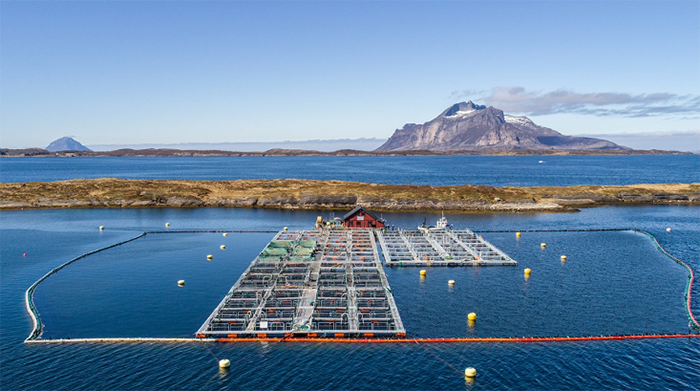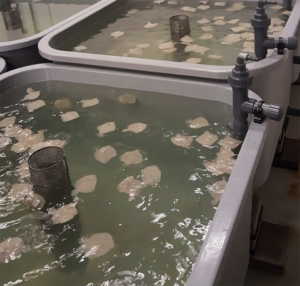GAIN project, funded by the EU Horizon 2020 Fund, examines feed ingredients for turbot, salmon, trout and sea bream

This is the third article in our series on “sustainable feeds.” This is part of a larger three-part series on sustainable aquaculture intensification in Europe, focused on “precision aquaculture,” “sustainable feeds” and “circular economy.” This work from the GAIN project is funded by the EU Horizon 2020 Fund. Each part in this series takes provides an introductory glance at the three topics, then explains how outputs from the GAIN project are contributing towards it, including the applicability to industry and governance.
Nutritionists have been testing new emerging ingredients for aquafeeds, and as alternative for traditional marine and plant meals and oils in a quest for more sustainability and circularity in the use of resources. Ingredients such as fish protein hydrolysates, processed animal proteins, yeast meals, insect meals, emerging vegetable meals/protein concentrates, microalgae, macroalgae, fish oil from trimmings, single cell oil, plant oils (e.g., linseed, rapeseed, sunflower, camelina), poultry fat, insect oil and DHA-rich algal products are all suitable alternatives to ingredients used in conventional formulations.
However, these ingredients have mostly been tested by researchers on a one-by-one basis. Moreover, most of them have limitations for their inclusion level (percent) due to nutritional or technical constraints, and thereby alternative formulations tend to be more complex, involving more ingredients than the conventional ones.
GAIN fish trials aimed to evaluate emerging ingredients, already commercially available, using different formulation concepts. The GAIN ingredient basket is based on circularity principles, maximizing resource efficiency, while contributing towards zero waste in the agro-food value chain, and looking for feed cost-effectiveness. It also takes into account social acceptance to optimize sustainability within the current/predictable regulatory framework.
The diets for four target species – salmon, turbot, sea bream and trout – were formulated and followed the principles outlined in Fig. 1, with adjustments for each species based on known nutritional requirements and tolerance to ingredients.

While welfare indicators, feed intake, gut health and immunity for all species were unaffected by the different diets, there were some interesting differences in the outcomes between the species. Salmon performed well with all diets tested, both in terms of growth and feed conversion, but alternative formulation had slightly worse feed conversions. The different diets had no effect on the presence of sea lice or gut health. Moreover, a panel of 100 consumers could not distinguish taste, odor, appearance or texture in samples of salmon that were fed the different diets.

In contrast, gilthead sea bream fed with the commercial diet and alternative diets without fish and livestock byproducts had a better FCR and improved bioavailability of certain nutrients. The results also suggested that these diets may lower the fish’s inflammation response, though the nutritionists are planning more trials to confirm this. There was no difference in digestibility of protein or phosphorous, which are both critical for sustaining growth of the animal.
For turbot and trout, the different diets did not affect growth rate or FCR. Turbot fed on the alternative diets did have a higher condition factor than those fed on the conventional diet. Moreover, the consumer panel could not distinguish taste, odor, appearance or texture in trout and turbot fed with the different diets.
Overall, this output of the GAIN project showed that these novel formulations based on sustainability and circular economy principles are viable options for these four fish species. The team is now examining the cost-effectiveness of these alternative diets and eventual positive or negative effects on fish health.
Now that you've finished reading the article ...
… we hope you’ll consider supporting our mission to document the evolution of the global aquaculture industry and share our vast network of contributors’ expansive knowledge every week.
By becoming a Global Seafood Alliance member, you’re ensuring that all of the pre-competitive work we do through member benefits, resources and events can continue. Individual membership costs just $50 a year. GSA individual and corporate members receive complimentary access to a series of GOAL virtual events beginning in April. Join now.
Not a GSA member? Join us.
Authors
-
Luis Conceição
Director of Research, R&D Nutrition, Sparos
-
Gabriella Pereira
Researcher, R&D Nutrition, Sparos
-
Alexandra Pounds
Assistant Researcher in Aquatic Food Security, Institute of Aquaculture, University of Stirling
Tagged With
Related Posts

Aquafeeds
A primer on sustainable feeds: Improving aquafeeds for sustainability, fish welfare and human nutrition
Improving aquafeed formulations can augment the sustainability and efficiency of aquaculture production – a new series from the GAIN project.

Aquafeeds
Sustainable feeds: Microalgae as a source of minerals in aquaculture
As seen through the GAIN project, adopting precision aquaculture tools improve feeding strategies and preventative measures for sea bass.

Intelligence
Precision salmon: Optimizing welfare through data-driven insights
The GAIN project’s precision aquaculture series continues with a look at how data-driven insights into salmon behavior can aid farm management.

Intelligence
Precision trout: Optimizing oxygen for better welfare and production
Dynamic modeling for oxygen optimization in trout leads to better welfare and production as part of GAIN, funded by the EU Horizon 2020 Fund.


